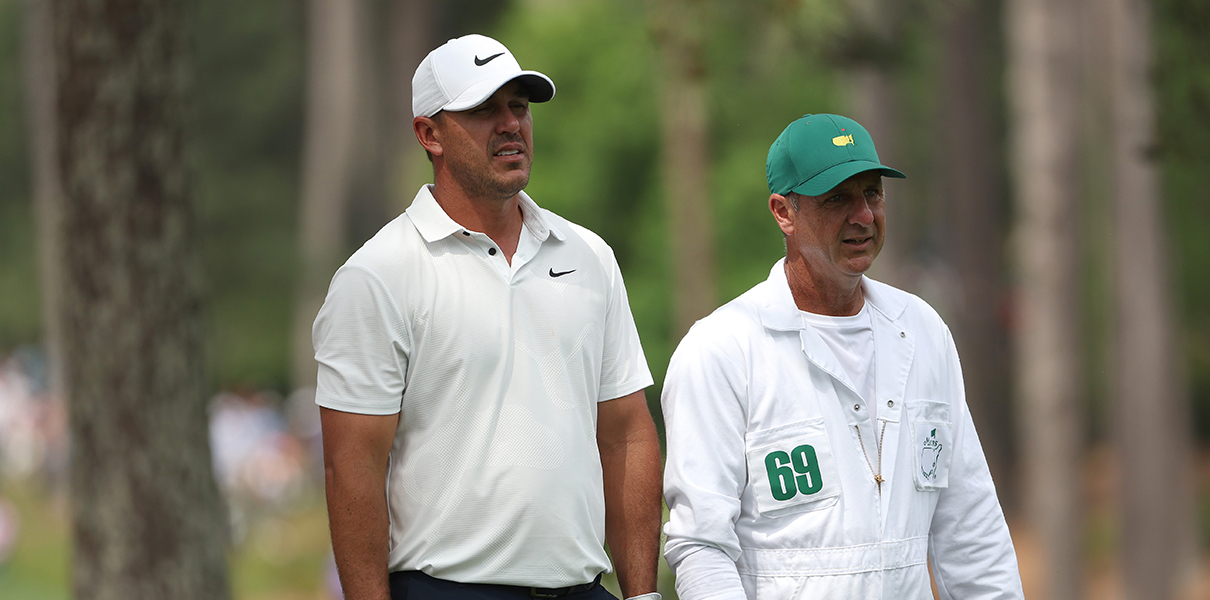The second major of the year has arrived with the prodigious East Course at Oak Hill Country Club in Rochester, New York hosting the 2023 PGA Championship. Completed by Donald Ross in 1926, Oak Hill has a rich history having hosted six previous majors along with the 1995 Ryder Cup. Throughout the decades, the course has been a model of parkland golf in America having hosted multiple championships. It has a sterling reputation as being one of the most equitable yet challenging tests of golf in America. After shooting 4-over par and finishing tied for 40th place at the 2013 PGA Championship here, Tiger Woods called Oak Hill “the toughest, fairest course I’ve ever played.”
The course underwent a near-complete remodel in 2019 by rising architect, Andrew Green in an effort to revive the vintage Ross design. While the overall routing remains the same, the course looks and plays completely different than in years past. “There’s a certain rugged kind of boldness to what we’ve done that’s meant to provide a little more intimidation and to place some demanding circumstances on the world’s best players,” Green said.
Featuring naturally scenic holes, elevation changes, narrow fairways, penal rough, and small raised greens surrounded by hazardous bunkers, it will play as a lengthy par 70 measuring 7,394 yards. PGA Championship layouts have usually been “U.S. Open-lite” type courses, but Oak Hill might be as close to a U.S. Open challenge as we’ve seen in years. Good shots will be rewarded. Poor shots punished.
Golfers will need to be strong with every club in their bag. On such a long course with dense rough, combined with the cooler May conditions of the upper northeast, both distance and accuracy off the tee will be crucial. Every golfer in the field will be forced to scramble for par or bogey from difficult positions throughout the week. With birdie opportunities rare, elite ball-strikers should rise to the top.

The Field
It is seemingly said for every major, but the PGA Championship really does have the strongest field, perhaps of all time. 102 of the top 103 players in the world rankings are in attendance at Oak Hill. Out for the season after back surgery, Will Zalatoris is the only exception. The 156-player field also includes 18 players from the rival LIV Golf League including major event stalwarts in Brooks Koepka, Dustin Johnson, and Cameron Smith.
The game’s two biggest heavyweights, Jon Rahm and Scottie Scheffler, headline the field as co-favorites once again. Rahm enters atop both the world rankings and the FedExCup standings after four wins this year, including the Masters and two other designated events, the Sentry Tournament of Champions and the Genesis Invitational. Second to Rahm, in both the world rankings and FedExCup standings, Scheffler has won two designated events at THE PLAYERS Championship and the WM Phoenix Open.
There are plenty of other big names in the second-tier of favorites that are ready to contend including two-time PGA Championship winner and Oak Hill member, Rory McIlroy, defending PGA champion, Justin Thomas, Xander Schauffele, Patrick Cantlay, Koepka, Johnson, and Tony Finau. Other past PGA champions in the field this week include Collin Morikawa, Jason Day, Phil Mickelson, Keegan Bradley, and Jimmy Walker.

Oak Hill Country Club – History
Oak Hill is one of the most complex courses built by legendary architect, Donald Ross. In 1924, the club commissioned Ross to build two new courses on a 355-acre plot of barren tumbling farmland in the town of Pittsford, New York. There was room for dual 18-hole layouts, and Ross proceeded to design two forward-thinking courses, the East and the West which opened for play in 1926.
The property already had the name of “Oak Hill” even though it only had a few dozen oaks. Local physician and club member, John Ralston Williams cultivated oak trees and took it upon himself, with Ross’s approval, to plant tens of thousands of them along the fairways and throughout the areas of rough. He sprinkled so many seedlings on the grounds that he claimed to have lost count at 75,000.
As the trees matured, so did Oak Hill’s reputation. In 1941 some of the greatest players in the world, including Ben Hogan, Sam Snead, and Walter Hagen, ventured to the course in response to an advertisement in the local newspaper of a $5,000 purse to the winner of the Rochester Times-Union Open. Snead won the event, putting Oak Hill on the national map. Even more notoriety came the following year at the same event when Ben Hogan broke the course record with a 64 in his opening round.
The course finally got to the “big stage” in 1949 with the opportunity to host the U.S. Amateur, followed by a pair of U.S. Opens in 1956 and 1968. In preparation for the 1956 tournament, Robert Trent Jones Sr carried out a series of modifications – adding yardage and pinching in bunkers – to ensure a difficult “major-type” test.
After the 1968 event, in which Lee Trevino tied the scoring record and became the first player to shoot four rounds in the 60s at the U.S. Open, the brass at Oak Hill feared the course needed to be toughened up. The USGA agreed that it would not warrant further championships until it was more difficult. So George Fazio and his nephew Tom were hired to make changes. While the course was more challenging, many felt they crossed the line by moving too far away from Ross’s original intentions. New holes at 5, 6, and 15 were a far cry from the original design.
Nonetheless, with a tougher course, in the decades that followed, Oak Hill continued its impressive run of hosting major events which included the 1980 PGA Championship, the 1989 U.S. Open, the 1995 Ryder Cup, the 2003 PGA Championship, and the 2013 PGA Championship.
2019 Oak Hill Course Restoration
As time advanced, so did certain negative characteristics at Oak Hill. It had taken a path in the opposite direction of the strategic layout that Ross had envisioned almost a century earlier. Green complexes had shrunk around the edges creating a punchbowl shape that allowed for more approach shots to stay on the putting surface. The original bentgrass greens had also become infiltrated with Poa annua. The bunkering modifications by both Jones and the Fazios had aged rapidly and completely changed in shape from Ross’s original hazardous traps.
As for all the tens of thousands of trees planted at the course’s beginnings, well, little trees become big trees. And Oak Hill had turned into a claustrophobic tree-impacted course with canopies that had outgrown where they had originally been located. They impacted approach shots as drives landing in the fairways often didn’t have a clear path into the greens thanks to overhanging branches.
The East Course had grown so far from its roots that in 2019, the club brought in architect Andrew Green to peel back the generations of tree growth and restore the bunkers and greens back to the style of Donald Ross. Green’s task was to revive the course back to Ross’ original intentions and to make it a venue fit for major championship golf once again.
When players arrive this week, those who played here last in 2013 will experience a vastly different Oak Hill. It is essentially a brand new course within the same construct and routing of how it looked and played previously. The restoration began in August 2019 with the rebuilding of all greens and bunkers. The old turf was replaced with pure bentgrass. Each green complex was rebuilt and redesigned to reclaim corners and edges that had receded. There is now the opportunity on each green to have up to four different pin placements that have never been seen before here.
Green substantially changed three holes, #4, #6, and #15, and created an all-new 5th hole – all with the intent of conforming to Ross’ design. Every bunker on the course has also been renovated to Ross’ original style. They are sharper around the edges, deeper, and more penal than ever before. Along with adding over 200 yards to the course length, Green also removed an unknown number of trees, most likely numbering close to 1,000. Fairways are just as narrow but much more wide open. Players will not have to punch out from behind trees and will have more options into the greens.
Former PGA professional, Jeff Sluman assisted Green with the renovation. Said Sluman on the changes, “The tree were choking Ross’ superb design and three holes designed by George and Tom Fazio 30-plus years earlier still looked out of place. The club agreed to a massive and controversial tree reduction and pruning. The results are simply outstanding, creating spectacular vistas and allowing the land to receive necessary sunlight and fresh air.”
The entirety of these changes should provide an even stronger test of golf that gives players more options off the tee and requires more strategy. “I think Andrew Green’s done a really good job,” Rory McIlroy said. “I think the renovation has hopefully restored the East Course back to its former glory.”

Finish Position and Strokes Gained Event History (2017-2022)
Combined PGA Championship/U.S. Open course history going back to 2017. Includes average finish position and Strokes Gained per round in each category. Players are sorted by SG: Total.
Why include U.S. Open courses? PGA Championship layouts have usually been “U.S. Open-lite” type courses. Amongst the majors, those two events are the most comparable. And Oak Hill might be as close to a U.S. Open challenge as we’ve seen in years.
Courses included in the data: The Country Club, Southern Hills, Torrey Pines South, Kiawah Island, Winged Foot, TPC Harding Park, Pebble Beach, Bethpage Black, Bellerive, Shinnecock, Quail Hollow, and Erin Hills.




Course Features
Measuring 7,394 yards, Oak Hill is a massively long par-70 parkland layout that ranks as the ninth longest course played on Tour over the past three years. Located in the Rochester, New York suburb of Pittsford, Oak Hill may end up rivaling both Southern Hills and Kiawah Island as the toughest course in recent memory to host a PGA Championship.
With an average winning score of 11-under in the last 13 PGA Championship events, it will be up to Kerry Haigh, the chief championship officer for the PGA of America, to set up a fair, yet stern course. When Jason Dufner won the 2013 PGA Championship at 10-under par it was on a course that played restricted and that encouraged a plodding and patient form of golf where driving accuracy amidst the thick tree-lined fairways was paramount.
From the elevated tee shot on the first hole to elevated greens throughout the course, the rolling terrain is pleasing to the eyes. The undulating layout offers both uphill and downhill holes as well as sloping fairways. Allen Creek meanders through nine holes and acts as the main water hazard by bisecting fairways on some holes and running right next to the green on others. It forces players to layup off the tee on a couple of holes, making the course play even longer. The course still has plenty of trees lining the fairways, just not as thick or intrusive as before.
In Andrew Green’s own words, the renovated bunkers are “bold and aggressive”. They have intimidating steep faces and may force players to hit sideways just to get out of jail. Green’s goal was to transform them into true hazards which can extract up to a full shot penalty depending on where the ball settles. On certain courses with tough lies around the green, players will often bail out into bunkers. That will not be a viable option this week and will place even more of a premium on ball-striking.
Said Green on the bunkering, “We tried to be rustic and rugged and pretty aggressive. The bunkers are most definitely hazards. I might catch a little criticism from them being so penal in places. They’re going to be tough. But part of the personality of this course is being a tough test. What we tried to do with green shapes, bunker shapes, the way they interact with one another, the way the golf shots flow through the property is very much the way Ross intended.”
With only two par 5s (each being over 600 yards), along with the allegedly “driveable” 14th hole not really being driveable, golfers will be hard-pressed to find any quality scoring chances. Even with the tree removal opening up many more playable options, there simply does not appear to be much let-up at Oak Hill.
With few water hazards or penalty areas, the lush rough has always been one of the primary defenses of the East Course. According to course Superintendent, Jeff Corcoran, “If you miss the fairway you’re gonna be in trouble. And once the competitive rounds start Thursday, the rough, per PGA of America mandate, will not be cut the rest of the week. So by Sunday, it could be extremely gnarly.”
It’s not the length of the rough as much as it is the thickness that poses such a challenge. Early reports have players doubting that anything longer than an 8-iron will allow them to reach the green when hitting from the rough. They are even experimenting with 9-woods to allow for a higher chance of getting the ball airborne.
As for turf conditions at Oak Hill, fairways are a mix of bentgrass and Poa annua. The aforementioned rough is at a length of 3-4 inches and is a combination of rye, bluegrass, and fescue. With this being the first major event since the restoration, greens will once again be pure bentgrass after years of having a bent/poa blend.
With the PGA Championship moving permanently to the month of May, Oak Hill will be the last course in the Northeast to host the event. Weather effects will definitely come into play this week. Temperatures will be downright cold in the mornings with 30s and 40s along with possible frost. The rough will also be much denser coming out of the spring growing season. The wind is also much more likely to be a factor this time of year. Looking at the week ahead, all of these conditions appear in the forecast including potential rain and storms on Friday and Saturday. Challenging conditions will only add to the potential carnage and make the course play even tougher.
Hole Preview
The East Course at Oak Hill presents a fantastic combination of short and long holes. Thanks to the renovation in 2019, each hole seemingly has multiple risk/reward options. The front nine is definitely more wide open than the back, and each hole has its own unique character. The front nine also gives players more chances to be aggressive off the tee. Bold lines can be taken over the bunkers on #4 and over the water on #6. It is on holes like this where carry distance off the tee is beneficial.
The back nine, and especially holes 12-18 is where the course really comes to life. Most feel they are the strongest stretch of holes on the course and offered a ton of variety. There is a short par-4, a few longer par-4s, a postage stamp 155-yard par-3, and a monstrous 623-yard par 5.
Usually, even on tough courses, par-5s tend to offer the easiest scoring opportunities. Not at Oak Hill though, with only two par-5s and each likely taking three quality shots just to reach the green. This should neutralize some of the advantages that longer hitters have off the tee because even they won’t be able to use their length to score well on those holes.

Continuing with the “long course” theme, two of the par-3s play over 230 yards and seven of the 12 par-4s will play at 460+ yards. These lengthy holes are one of the reasons that accuracy with long irons and woods from 200+ yards into the green will be crucial. As for the short 320-yard par-4 14th hole, technically it is reachable with a perfect drive. But with hazards surrounding an elevated uphill green, most players will lay up here and try to wedge/putt their way into one of the few birdie chances on the entire course.
Oak Hill’s final three holes make up one of the most challenging finishing stretches in major championship golf. It begins with the 460-yard 16th hole featuring a downhill tee shot and an open-fronted green with a downslope of short grass. Two large bunkers surround and protect the front left and right sides of the green.
The 17th is a 500-yard par 4. A drive of at least 300 yards is needed to reach the crest of the fairway and to pass the oaks on the right for a clear view of the low green guarded on the left by a bunker and elevated chocolate drop mounds on the right. These hazards make recoveries difficult.
The finishing 18th is another 500-yard par 4 that is a prodigious dog leg right with bunkers guarding the inside corner of the dogleg. The defining feature of the hole is the green which is placed on a ridge over a 12-foot depression.
Strokes Gained Analysis
Off the Tee
When the 2013 PGA Championship was held here, golfers were more or less playing target golf on a course that favored accuracy over power. While hitting fairways definitely still matters, the need to shape shots around trees based on the demands of the hole is gone this time around. The reduction of trees will also allow players numerous options off each tee and will allow them to take more aggressive lines while still understanding the main goal of avoiding the rough and the dangerous fairway bunkers. Total Driving which combines distance and accuracy off the tee will be a key stat this week.
In other words, while a “bomb and gouge” strategy won’t be ideal thanks to the rough, the power game is an option once again at Oak Hill and should favor the longer accurate drivers of the ball. With the rough just as deep five yards off the fairway compared to 40 yards wide, stronger players who have the clubhead speed to hit out of the thick grass will have a clear advantage (ala Bryson DeChambeau in the 2020 U.S. Open at Winged Foot). Players attempting to cut across any dog legs will have to take tight lines in order to avoid both the bunkers and rough. With many of the bunkers in the 300-310 yard range, players that have a carry distance of 310+ yards should have an edge.
While Oak Hill’s fairways average 27 yards wide they squeeze down to the 20-24 range in the landing area on some holes. Shorter-hitting fairway-finders can still have success provided they have a level of accuracy from 200+ yards and are stellar around the greens. Kerry Haigh insists that the premium on accuracy “hasn’t gone away”, only that recovery shots toward the green will be possible this year in a way they were not before. Early reports also have the fairways playing firmer than expected which could lead to drives landing in the fairway and ending up in the rough.
Approach
With such dense rough along with the 4th smallest greens surrounded by penal bunkers, gaining strokes on approach will be a task this week. The expanded green surfaces allow for more pin locations near the edges of holes. Add in the abundance of long par 4s and numerous elevated greens that will require flighted approach shots and it’s easy to see why Oak Hill demands elite ball-striking. Even when playing from the fairway, the course will allow safe shots to the middle of the elevated greens but aiming too aggressively at flags will expose players to the many bunkers and steep embankments requiring a delicate chip back up to the surface.
Trying to advance the ball from the rough might become the main course-related storyline of the tournament. In practice rounds thus far, many players are resorting to simply hacking the ball out and basically taking a penalty shot. Grass hummocks that line some of the fairways will also produce awkward lies that will affect approaches from the 150-200 yard range. With approximately 55% of approach shots coming from 175+ yards, fairway accuracy really is at a premium this week.
Around the Green and Putting
One of the areas that make Oak Hill such a unique course is the creative green complexes that demand a variety of shots when missing the green. Along with the bunkers and thick rough, certain holes have newly created tightly mowed run-off areas that will present a significant challenge to players that are not accurate on approach. An example of this is on the renovated 15th hole where the pond guarding the green was removed and in its place sits a close-cropped area below the elevated green where players must decide whether to chip or putt up onto the surface.
With greens only 4,500 square feet on average, there will be plenty of 20-40 yard recovery pitch shots that will test players’ short-game skills. Along with being immaculate in design, the greenside bunkers are so penal and steep with the same thick rough on their faces that balls can even get lodged on the slope creating near-impossible recovery shots. Perfectly placed “tear-drop” mounds surrounding certain greens can also have the same effect causing difficult lies.
When Ross designed courses, he loved to focus his energy on the greens, which, in typical Ross design, are small, elevated, and tend to slope from back to front. Oak Hill showcases some of Ross’ most uniquely shaped greens with many being remodeled to the square pattern that the course originated with. Along with recapturing the spaces around the perimeters of the greens and squaring off the edges, Andrew Green preserved the interior contours of most of the putting surfaces.
With the tournament being in May, and with no Sub-Air system under the greens, it will interesting to see how the greens respond to any precipitation. Early reports are that the greens are receptive but fast. Haigh said that they will play at “championship speed” which means they will be at an appropriate speed for the best players in the world related to the amount of contours within each green complex.
Most Important Stats For Success at the PGA Championship
*In order of importance
Weather Forecast – Rochester, New York

Want to see who the experts are betting this week? Head over to Betsperts Golf to find special deals on monthly or yearly memberships.






































